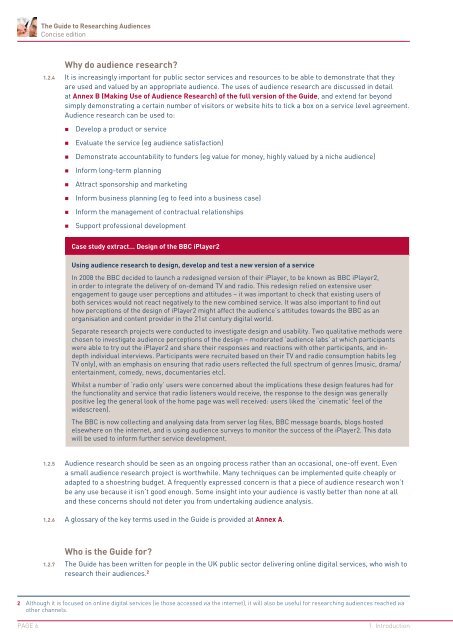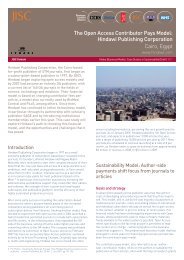A Concise Guide to Researching Audiences - Strategic Content ...
A Concise Guide to Researching Audiences - Strategic Content ...
A Concise Guide to Researching Audiences - Strategic Content ...
You also want an ePaper? Increase the reach of your titles
YUMPU automatically turns print PDFs into web optimized ePapers that Google loves.
The <strong>Guide</strong> <strong>to</strong> <strong>Researching</strong> <strong>Audiences</strong><strong>Concise</strong> editionWhy do audience research?1.2.4 It is increasingly important for public sec<strong>to</strong>r services and resources <strong>to</strong> be able <strong>to</strong> demonstrate that theyare used and valued by an appropriate audience. The uses of audience research are discussed in detailat Annex B (Making Use of Audience Research) of the full version of the <strong>Guide</strong>, and extend far beyondsimply demonstrating a certain number of visi<strong>to</strong>rs or website hits <strong>to</strong> tick a box on a service level agreement.Audience research can be used <strong>to</strong>:• Develop a product or service• Evaluate the service (eg audience satisfaction)• Demonstrate accountability <strong>to</strong> funders (eg value for money, highly valued by a niche audience)• Inform long-term planning• Attract sponsorship and marketing• Inform business planning (eg <strong>to</strong> feed in<strong>to</strong> a business case)• Inform the management of contractual relationships• Support professional developmentCase study extract… Design of the BBC iPlayer2Using audience research <strong>to</strong> design, develop and test a new version of a serviceIn 2008 the BBC decided <strong>to</strong> launch a redesigned version of their iPlayer, <strong>to</strong> be known as BBC iPlayer2,in order <strong>to</strong> integrate the delivery of on-demand TV and radio. This redesign relied on extensive userengagement <strong>to</strong> gauge user perceptions and attitudes – it was important <strong>to</strong> check that existing users ofboth services would not react negatively <strong>to</strong> the new combined service. It was also important <strong>to</strong> find outhow perceptions of the design of iPlayer2 might affect the audience’s attitudes <strong>to</strong>wards the BBC as anorganisation and content provider in the 21st century digital world.Separate research projects were conducted <strong>to</strong> investigate design and usability. Two qualitative methods werechosen <strong>to</strong> investigate audience perceptions of the design – moderated ‘audience labs’ at which participantswere able <strong>to</strong> try out the iPlayer2 and share their responses and reactions with other participants, and indepthindividual interviews. Participants were recruited based on their TV and radio consumption habits (egTV only), with an emphasis on ensuring that radio users reflected the full spectrum of genres (music, drama/entertainment, comedy, news, documentaries etc).Whilst a number of ‘radio only’ users were concerned about the implications these design features had forthe functionality and service that radio listeners would receive, the response <strong>to</strong> the design was generallypositive (eg the general look of the home page was well received: users liked the ‘cinematic’ feel of thewidescreen).The BBC is now collecting and analysing data from server log files, BBC message boards, blogs hostedelsewhere on the internet, and is using audience surveys <strong>to</strong> moni<strong>to</strong>r the success of the iPlayer2. This datawill be used <strong>to</strong> inform further service development.1.2.5 Audience research should be seen as an ongoing process rather than an occasional, one-off event. Evena small audience research project is worthwhile. Many techniques can be implemented quite cheaply oradapted <strong>to</strong> a shoestring budget. A frequently expressed concern is that a piece of audience research won’tbe any use because it isn’t good enough. Some insight in<strong>to</strong> your audience is vastly better than none at alland these concerns should not deter you from undertaking audience analysis.1.2.6 A glossary of the key terms used in the <strong>Guide</strong> is provided at Annex A.Who is the <strong>Guide</strong> for?1.2.7 The <strong>Guide</strong> has been written for people in the UK public sec<strong>to</strong>r delivering online digital services, who wish <strong>to</strong>research their audiences. 22 Although it is focused on online digital services (ie those accessed via the internet), it will also be useful for researching audiences reached viaother channels.PAGE 61. Introduction



